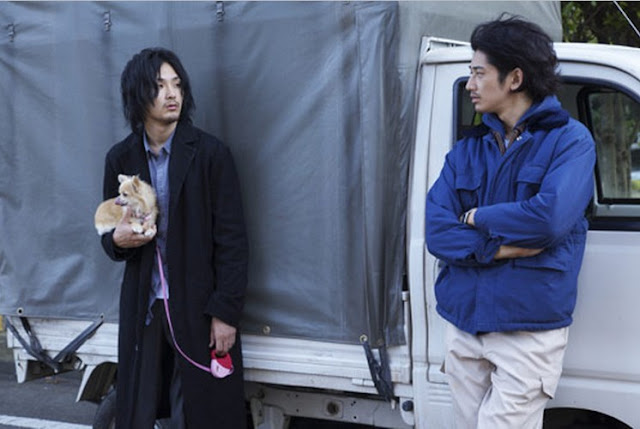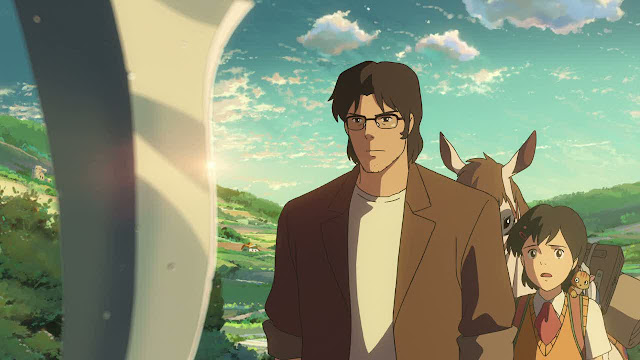The fictitious town of Mahoro in
Kanagawa prefecture is one of those inbetween communities framing the edges of Metro
Tokyo. Not a major city center in itself and with most people commuting to jobs in Tokyo, there’s really not much of
interest going on. It doesn't even draw
tourists as it’s too far from the sea and not in the mountains. The people who live there don’t really have
much ambition to leave, and if they do, they usually come drifting back.
At least, that is how it seems to Keisuke
Tada (Eita), who runs a benri-ya (do-it-all-house) near the
train station. He advertises himself as
a jack-of-all-trades doing everything from babysitting a chihuahua to working
as a handyman. He’s handsome and seems
intelligent, so it is a bit of a mystery as to why he is doing such low paying
work instead of working for a company in Tokyo.
Order from cdjapan:
This mystery is the main element
that creates tension in the film and awakes our curiosity to learn more about
him. The mystery deepens one evening
when, after finishing up a job spying on bus drivers for their suspicious boss,
Tada discovers that the chihuahua he is babysitting has gone missing from his
truck. He finds the dog sitting on
the lap of a guy who looks a bit down on his luck at the bus stop. It turns out that this man, Haruhiko Gyoten (Ryuhei Matsuda), went to school
together with Tada, and that Tada had been responsible for Gyoten seriously
injuring himself on a table saw during shop class.
Gyoten uses this old injury to guilt
Tada into letting him crash at his place for the night. One night turns into several days, and before
long Gyoten is a permanent fixture at the benri-ya tagging along on jobs as Tada’s semi-reluctant assistant. Although he seems like a deadbeat, there are
many clues that Gyoten too may have once had a regular job. He chastises Tada for not marketing himself
properly and wonders why Tada, who seemed to have a promising future in front
of him, is stuck in a dead end business.
Both men also seem determined to
stay on the fringes of life, but they keep getting pulled into sticky
situations due to their natural desires to help others. They are drawn into action by a young boy called
Yura (Kota Yokoyama) whose mother (Manami Honjou) has hired them to pick
him up from cram school. They start to
realize that Yura’s strange behaviour is more than just insolence but is hiding
the fact that someone is using him and they decide to help him get out of his predicament. This subplot is tied up with another subplot
about a “Columbian” prostitute called Lulu (Reiko Kataoka) and her fellow prostitute and house mate Haishi (Anne Suzuki) and the dodgy men in their
lives.
The film is adapted from Miuri Shion’s bestselling novel of the
same name which won the Naoki Sanjugo Prize in 2006. It starts out well, and the relationship
between Tada and Gyoten evolves in an interesting way. Both Eita and Matsuda are excellent actors
and the mystery surrounding their circumstances generates interest in what
little plot is retained in this adaptation.
Unfortunately, the film has trouble sustaining interest and has many moments that just don't make sense at all (yes it's great to rescue a prostitute from a stalker but throwing her onto a train without belongings/money/somewhere to go/telling her friend is a bit odd to say the least). One could argue
that the directionlessness of the plot mimics the directionlessness of the two
main protagonists, but the there are just too many head-scratching moments that
lessen one’s enjoyment of the film. The
film’s biggest flaws are the one-dimensional female characters who would be
laughable if they weren’t so disturbing.
Director Omori Tatsushi won international acclaim for his avant-garde
directorial debut The Whispering of the
Gods (2005). While Tada’s Do-It-All
House shows that he is quite good at getting great performances out of
his male actors, the film just suffers from a problem quite prevalent in contemporary
Japanese films: weak editorial decisions.
With a few nips and tucks to the second half of the film, this could
have been a great star vehicle of Eita and Matsuda.
Catherine Munroe Hotes 2012













![Mai Bridge-no Ito 1 / Yamamura Kouji [Author] (Book)](https://cdn.statically.io/img/lh3.googleusercontent.com/blogger_img_proxy/AEn0k_syVIkuNmmz-i70NQib-9tCSStKufRjbUfYK3WUSMIRnT-hu0Ias7jAcEGpGIJFXZBi3uot5aPUMIvuNoMcAKqH7zScB0vY-dM0nbKoYx8FaFNJidTNBxk=s0-d)
![Mai Bridge-no Ito 2 / Yamamura Kouji [Author] (Book)](https://cdn.statically.io/img/lh3.googleusercontent.com/blogger_img_proxy/AEn0k_sZblnpe31plG7GeuNxD0ZG3HDJ6cjnQWxqXnVox34ghx2u9xxm_ZdN5-iEa6su_sRR_CwVsAyNa9WqinDT-GmDTR_ib_SHSVXSZU9cdC3fgc6c9xd4B6w=s0-d)






